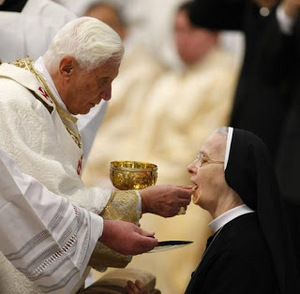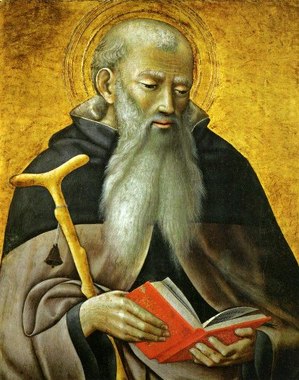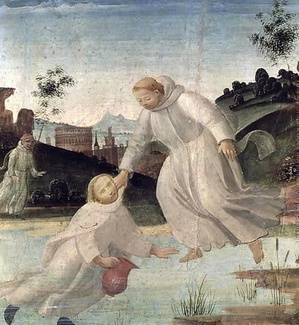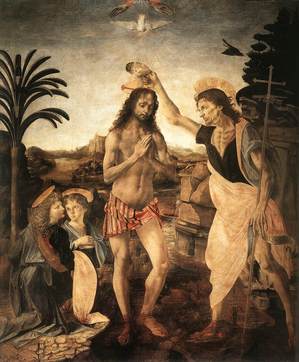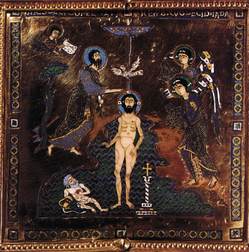Three things came at me recently that I think needs to be looked at with intellectual and affective honesty. That is, from a perspective of faith and reason, the mind and the heart. The issue of how we receive Holy Communion.
The sacraments are events
[T]he sacraments constitute the events of a time which is the tension between the Resurrection and the Parousia …. Thus during the delay of the Parousia, the Eucharist prevents humanity, in this foretaste of celestial food …. And the Eucharist is the sacrament of unity which gathers about Christ of glory, present in the community, all nations in order to offer them through His hands to the Father.
Saint Anthony Anthony of the Desert
Saint Anthony, father of Monks, intercede for the monastic life in the present day for the monks and nuns can live his consecration in awe and charity at all pleasing only to God.
Saint Anthony Anthony of the Desert (c. 251-356) was a friend of God, and therefore a son and brother to others. His friendship with God flowed from his obedience (his listening to and building his relationship).
He’s known as the founder of monasticism. His rule of life established guidelines for living together as Christians. This is what came to be known as “monastic,” the intense and purpose driven living of the Gospel. Following the death of his parents and providing for his younger sister, Anthony became a monk at 20; his method was to live in total solitude on a desert mountain near the Nile River and eating only bread and water, which he never tasted before sunset, and sometimes only once in two, three, or four days. In the spiritual life the desert is the place to do battle with sin. Anthony shows us that it possible to overcome the temptations of the devil; emerging about 20 years later from total seclusion to instruct hermits in the ways of the Gospel, monasticism, Anthony gave witness to the power of Jesus Christ in his capacity to the heal the sick, being a spiritual father, by casting out demons and preaching. From him we begin to realize that not everything lasts forever. It is said that he lived at least to 100 years.
It is Saint Athanasius’s Life of Saint Anthony that perpetuates the narrative and inspired waves of monks who civilized and evangelized Europe and the Near East. Anthony established a monastery between the Nile and the Red Sea, which exists today.
Saint Anthony, pray for us. Help is to renew and in some cases, refound the monastic living.
Ibrahim Isaac Sidrak elected new Patriarch for Catholic Copts
 The Most Reverend Ibrahim Isaac Sidrak, 57, was elected by the Synod of Bishop of the Catholic Coptic Church, to be Patriarch on January 15, 2013. He succeeds Antonio Cardinal Naguib.
The Most Reverend Ibrahim Isaac Sidrak, 57, was elected by the Synod of Bishop of the Catholic Coptic Church, to be Patriarch on January 15, 2013. He succeeds Antonio Cardinal Naguib.
Continue reading Ibrahim Isaac Sidrak elected new Patriarch for Catholic Copts
Walter Ciszek: Chained, but Free
 Father Walter Ciszek (1904-84) is likely to be one the 20th century’s finest American priests –ever. If you don’t believe me read John Levko’s “Chained, but Free: How Walter Ciszek gained spiritual liberation in Lubyanka prison.”
Father Walter Ciszek (1904-84) is likely to be one the 20th century’s finest American priests –ever. If you don’t believe me read John Levko’s “Chained, but Free: How Walter Ciszek gained spiritual liberation in Lubyanka prison.”
Charles J. Chaput to Campus Ministers: enable students to hear God
Speaking to Catholic campus ministers on January 10, 2013 in Florida, Capuchin Archbishop Charles J. Chaput addresses the urgent need to give good, authentic formation to college students in the ways of God. As he says, the status quo is not good enough. Chessy programs are not satisfying.
The frequent question is how do we evangelize and give good formation to our college students today? I think we know what needs to be done. SO, let’s get to work; let’s teach, lead and pray. Campus ministry has an objective: seek the face of God; to enable one to hear the voice of God in the still small whisper. Of course, the issues of formation are not germane only to the college aged.
An excerpt: Campus ministry needs to lead young adults not just to good religious activities that keep them busy, but also to the beauty of interior silence that enables a person to hear the will of God and entrust his or her life to Jesus Christ.
The whole text: Charles J. Chaput on Catholic Campus Ministry Association 2013.pdf
Saints Maurus and Placid
In the Benedictine tradition today is the feast of the young disciples of Saint Benedict, Maurus and Placid. The tradition holds that after the holy Benedict had established his twelve monasteries at Subiaco, noble Christians came from Rome, presenting their sons to be raised and educated among the monks. Not unusual given the state of Roman culture at that time. Among them were Maurus, an adolescent, the son of Euthicus, and Placid son of the patrician Tertullus. These young people become the first “oblates” in monastic life; they become models for all Benedictine Oblates today.
While the names of Maurus and Placid are not well known in “normal” Catholic circles except in Benedictine monasteries, we do recognize a few things today because of them. The oblation of the family to the Man of Blessing is where we get the idea of an Oblate in the Benedictine charism. You may have heard of the Blessing the Sick through the Intercession of Saint Maurus or even be familiar with the famous story of being saved from drowning.
The narrative of Placid being saved is given to us in the Dialogues of Saint Gregory the Great. There Gregory tells us Maurus and Placid went to fetch water in the lake. Placid falls into the water. Saint Benedict, aware of the situation due to God’s grace, sends Maurus to rescue the child Placid. Maurus, having received his abbot’s blessing, runs over the surface of the water, grabs Placid by the hair, pulls him out, and then runs back over the water to dry land, carrying the little one in his arms. Saint Benedict attributes the miracle to Mauris’ obedience; Maurus attributes it to Saint Benedict. But it was Placid who settles the debate: “When you pulled me out of the water, he says, I saw over my head Father Abbot’s hood, and I saw that it was he who pulled me from the water.” Listening to the Collect it seems that obedience wins: both Benedict and today’s saints are correct.
For us the story of Saints Maurus and Placid is very much connected with the notion of to whom do we belong; whom do we follow. That is, with whom do we share friendship (on the supernatural level)? God or creation? What we see in these two is the development in Benedict’s line of spiritual paternity of persevering in the seeking of God. One can only wonder what better eye witnesses there could be than Maurus and Placid in the mercy of God and the trust in Divine assistance in times of suffering. Perhaps this is why they are asked for intercession for the sick and why became patrons of Benedictine novices.
Chaput speaks about the issues
Archbishop Charles J. Chaput, OFM, Cap., the archbishop of Philadelphia, has been in the center of a lot revisioning of the temporal affairs in the archdiocese since he came just over a year ago. He’s had some hard decisions to make when comes to education, parish buildings, financial transparency, etc. Then there’s sex abuse crisis and Obamacare.
Pope Benedict’s baptism of 20 children today: they inherit eternal life
An annual tradition on the Feast of the Baptism of the Lord is the baptism of the children by the Pope in the Sistine Chapel. Today, Benedict baptized 20 children. This is the same place where the cardinals meet under lock and key to elect a new pontiff. Here is the pope’s teaching.
The joy arising from the celebration of Christmas finds its completion today in the Feast of the Baptism of the Lord. To this joy is added another reason for those of us who are gathered here: in the Sacrament of Baptism that will soon be administered to these infants, the living and active presence of the Holy Spirit is manifested, enriching the Church with new children, enlivening and making them grow, and we cannot help but rejoice. I wish to extend a special greeting to you, dear parents and godparents, who today bear witness to your faith by requesting Baptism for these children, because they are regenerated to new life in Christ and become part of the community of believers.
The Gospel account of Jesus’ baptism, which we have heard today according to St Luke’s account, shows the path of abasement and humility that the Son of God freely chose in order to adhere to the plan of the Father, to be obedient to His loving will for mankind in all things, even to the sacrifice on the Cross. Having reached adulthood, Jesus begins His public ministry by going to the River Jordan to receive from John the baptism of repentance and conversion. What happens may appear paradoxical to our eyes. Does Jesus need repentance and conversion? Of course not. Yet He Who is without sin is placed among the sinners to be baptized, to fulfil this act of repentance; the Holy One of God joins those who recognize in themselves the need for forgiveness and ask God for the gift of conversion – that is, the grace to turn to Him with their whole heart, to be totally His. Jesus wills to put Himself on the side of sinners, by being in solidarity with them, expressing the nearness of God. Jesus shows solidarity with us, with our effort to convert, to leave behind our selfishness, to detach ourselves from our sins, saying to us that if we accept Him into our lives, He is able to raise us up and lead us the heights of God the Father. And this solidarity of Jesus is not, so to speak, a mere exercise of the mind and will. Jesus was really immersed in our human condition; He lived it to the utmost – although without sin – and in such a way that He understands weakness and fragility. Therefore He is moved to compassion; He chooses to “suffer with” men, to be penitent together with us. This is the work of God that Jesus wishes to accomplish: the divine mission to heal those who are wounded and to cure those who are sick, to take upon Himself the sin of the world.
Continue reading Pope Benedict’s baptism of 20 children today: they inherit eternal life
The Spirit descends
Jesus comes up out of the water and raises up the whole world with him. He sees the heavens rent open, which Adam had barred to himself and his posterity even as paradise was barred by a flaming sword. The Spirit comes to him as to an equal, bearing witness to his Godhead. A voice bears witness to him from heaven, because he had come from heaven. The Spirit descends in bodily form like the dove that so long ago announced the ending of the flood, and so gives honor to the body that is one with God.
Saint Gregory Nazianzen
